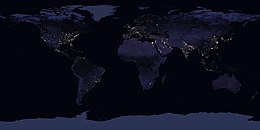
Back جغرافيا السكان Arabic Əhali coğrafiyası Azerbaijani География на населението Bulgarian जनसंख्या भूगोल Bihari জনসংখ্যা ভূগোল Bengali/Bangla Demogeografija BS Geografia de la població Catalan جوگرافیای دانیشتووان CKB Geografie obyvatelstva Czech Bevölkerungsgeographie German
This article includes a list of general references, but it lacks sufficient corresponding inline citations. (November 2015) |

| Part of a series on |
| Geography |
|---|
 |
Population geographyis the study of the distribution, composition, migration, and growth of human populations in relation to the geographic characteristics of specific area. It focuses on how populations are distributed across space, the factors influencing these distributions, and the implications for resources, environment, and societal development. This branch of geography integrates demographic data with spatial analysis to understand patterns such as population density, urbanization, and migration trends. Population geography involves demography in a geographical perspective.[a] It focuses on the characteristics of population distributions that change in a spatial context. This often involves factors such as where population is found and how the size and composition of these population is regulated by the demographic processes of fertility, mortality, and migration.[1]
Contributions to population geography are cross-disciplinary because geographical epistemologies related to environment, place and space have been developed at various times.[2] Related disciplines include geography, demography, sociology, and economics.
Cite error: There are <ref group=lower-alpha> tags or {{efn}} templates on this page, but the references will not show without a {{reflist|group=lower-alpha}} template or {{notelist}} template (see the help page).
- ^ Rogers, Alisdair; Castree, Noel; Kitchin, Rob (19 September 2013). "Population geography". A Dictionary of Human Geography. Oxford University Press. ISBN 9780199599868.
- ^ Gresh, Ashley; Maharaj, Pranitha (2013). "Policy and Programme Responses". In Maharaj, Pranitha (ed.). Aging and Health in Africa. International Perspectives on Aging. Vol. 4. Springer US. pp. 211–236. doi:10.1007/978-1-4419-8357-2_11. ISBN 9781441983572.